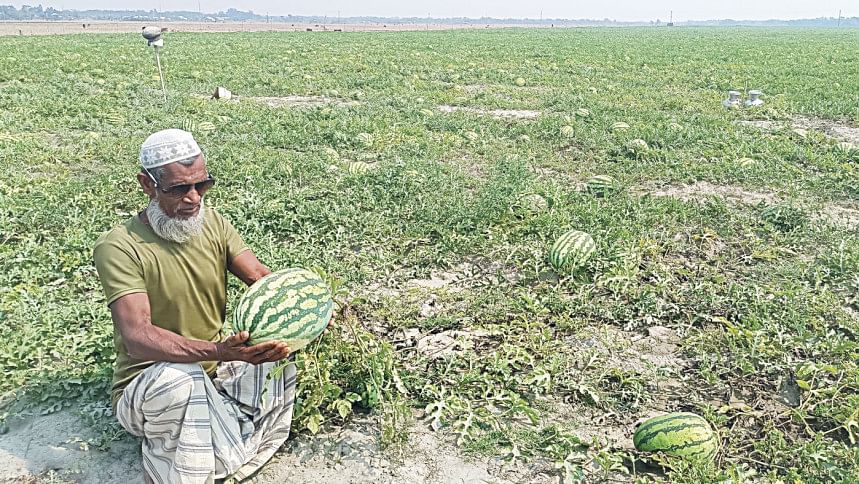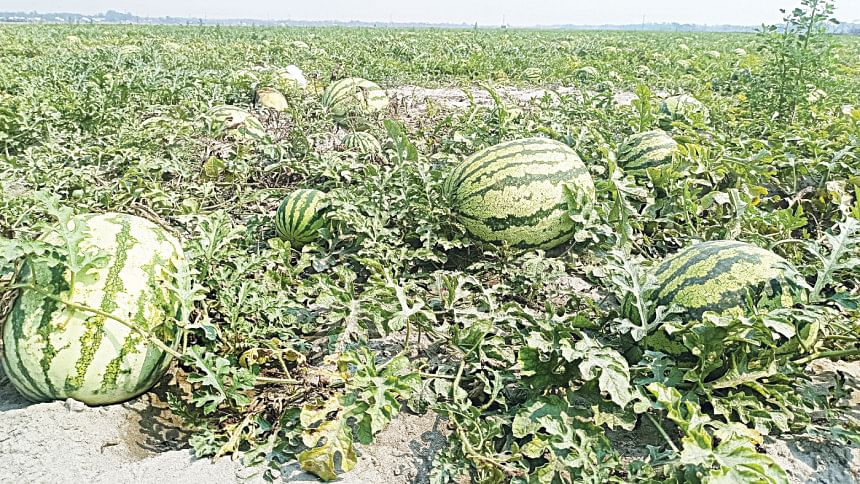Watermelon farmers getting good yields, prices

Watermelon farmers in southern Bangladesh are pleased to be getting bumper yields and prices early this season as their produce can now reach markets all over the country thanks to the improved connectivity provided by Padma Bridge.
For the past three years, farmers in more than 100 char areas of Patuakhali, Bhola and Barishal have been planting watermelon in December rather than January in order to begin harvests by mid-February, when prices are typically higher.
Growers say yields are better this year as the weather remained favourable and even though middlemen eat up most of the profit, they are getting good returns based on higher sales.
This is because it now takes less time for wholesalers to carry watermelon from the region to other parts of the country as the opening of the Padma Bridge facilitated road transport, reducing the fruit's chances of rotting along the way.
Mosharef Mia, a famer of Bhola sadar upazila, said he planted watermelon on one bigha of land at a cost of Tk 1.2 lakh and has already sold Tk 2,70 lakh worth of the fruit.

Hanif Bepari, a local watermelon trader, said Bhola witnessed bumper production this season. So far, Bepari has sold more than Tk 10 lakh worth of watermelon at a wholesale centre in Gazipur.
Watermelons weighting between eight to 12 kilogrammes (kgs) are selling for as much as Tk 350 per piece while five to seven kg watermelons are going for about Tk 220. Meanwhile, smaller sizes are priced at an average of around Tk 80 per piece.
Wasirul Kabir, deputy director of the Department of Agricultural Extension (DAE) in Bhola, said watermelon cultivation has been expanding in the district for the past three years.
Kabir then said 18,383 hectares of land in the region was used to grow watermelon this year while it was 12,249 hectares last year.
"There were no stormy rains this year, leading to good yields that are fetching better prices," he added.
Elsewhere in Patuakhali, the fruit was cultivated on 28,545 hectares of land this year compared to 22,890 hectares in 2022, according to sources at the district DAE office.
Acreage is highest in the Galachipa and Rangabali upazilas, where some 11,750 hectares and 8,262 hectares of land respectively have been brought under cultivation.
The fruit was also planted on 3,131 hectares of land in Bauphal upazila, 2,370 hectares in Kalapara upazila, 1,850 hectares in Dasmina upazila, 1,197 hectares in Patuakhali sadar upazila, 120 hectares in Dumki upazila, and 65 hectares in Mirzaganj upazila.
Mohammad Nazrul Islam, deputy director of the Patuakhali DAE, said the cultivation and yield of watermelon has been good this year.
Islam went on to say that due to the opening of Padma Bridge, watermelons grown in the district are being easily transported all over the country.
"As a result, wholesalers are buying watermelons at a good price, ensuring better profits for farmers," he added.
Faruk Hossain, a grower of Galachipa upazila, said only those who managed to harvest their watermelons early are benefitting from good prices at present.
Sources at the Patuakhali DAE say that each hectare is producing an average of up to 45 tonnes of watermelon. About Tk 1,800 crore worth of watermelon are sold in the district each year, making it the backbone of the local economy.
Ganesh Dutta, a watermelon wholesaler in Barishal, said there will be huge demand for the fruit during the upcoming month of Ramadan.
In anticipation of this demand, watermelon prices are already high in wholesale and retail markets, he added.
Kartik Dutta, secretary of the Barisal District Fruit Traders Association, said the price of watermelon is now higher than what it was last year.
Md Harun-Or-Rashid, additional managing director of the Barishal DAE, said watermelon was cultivated on 34,183 hectares of land in the district this year. The total produce is valued at around Tk 7,000 crore at the wholesale level while it is more than Tk 10,000 crore at the retail level.
Farmers have become more interested in watermelon cultivation due to the good prices and as a result, the fruit has become the main cash crop in the region.

 For all latest news, follow The Daily Star's Google News channel.
For all latest news, follow The Daily Star's Google News channel. 







Comments